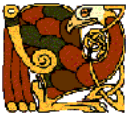ThisIsChurch.com
|
Celtic Christianity
 The term `Celtic Church’ is used to describe almost the
earliest native form of Christianity in the islands of Britain and
Ireland, it dates from around 400. The Celtic Church established itself as
the most successful evangelistic movement Britain has ever seen with
people like Ninian, the first known evangelist in Scotland, David, who had
such an influence on Wales, Patrick, a Scot who evangelised Ireland,
Columba, an Irishman who led many in Scotland to Christ.
The term `Celtic Church’ is used to describe almost the
earliest native form of Christianity in the islands of Britain and
Ireland, it dates from around 400. The Celtic Church established itself as
the most successful evangelistic movement Britain has ever seen with
people like Ninian, the first known evangelist in Scotland, David, who had
such an influence on Wales, Patrick, a Scot who evangelised Ireland,
Columba, an Irishman who led many in Scotland to Christ.
In the Celtic tradition the Holy Spirit is represented as a bird, but not
the peaceful and serene dove landing on Jesus at his baptism. For their
symbol of the Holy Spirit, the Celtic church people chose the Wild Gose, (
An Geadh-Glas) This has become, the logo and name for the worship branch
of the Iona Community.
Why did the Wild Goose speak to those ancient Celtic Christians? To begin
with, wild geese aren’t controllable. You can’t restrain a wild goose and
bend it to your will. They’re raucous and loud. Unlike the sweet and
calming cooing of a dove, a goose’s honk is strong, challenging, strident
and unnerving – and just a bit scary.
In much the same way the Spirit of God can be, demanding and unsettling.
Think about the story of Pentecost, and the impression the disciples made
on the crowd. People thought they were drunk and disorderly!
Its one thing for a gentle dove to descend peacefully on Jesus – it’s
something all together different when the Spirit descends like a wild,
noisy goose!
Early Christianity in Celtic lands had a more natural,
less imperial feel than it did elsewhere and it’s spirituality is reviving
today. This has a strong sense of God’s presence in creation and in
everyday life, celebrates God through all the senses, releases creativity,
respects both women’s and men’s gifts and values contemplation.
Celtic Christians see life as a pilgrimage, use earthy yet poetic prayers,
and have a vivid sense of saints, angels and the unseen world.
They believe that what is deepest in us is the image of God. Sin has
distorted but not erased it. However, the struggle against evil in the
human and the spirit world is real. Memorising Scripture, praying daily
following the natural rhythm of the sun and the seasons, and working with
a soul friend to overcome destructive passions are a means to this.
The early Celtic churches were communities of work, prayer and hospitality
at the heart of local life, and those with a Celtic vision seek to restore
these features to church life today.
The Celtic way of mission is to plant the experience of Christ within the
natural patterns of the people, to be friendly towards all people of good
will and respect other faiths.
Many people today see Celtic spirituality as a way to weave together again
the separated strands of Christianity, and to heal a fragmented world.
Creation as Sacrament
Because the Celtic Church had not been infected with a dualistic outlook
on creation, they did not see matter as evil, nor the spiritual world as
divorced from the material. Thus, they looked on Creation around them as
one great hymn of praise to its Creator, reflecting His nature and
character, whilst not actually being God itself.
Because the Celtic believers lived in a rural world, life was lived in
rhythm with creation and was made up of work, worship and rest, with
everything cloaked in prayer. Thus, many Celtic prayers are associated
with simple events such as rising in the morning, lying down at night,
cleaning a hearth or baking bread.
They saw the creatures around them as fellow servants of God. So, on one
occasion, Cuthbert chided a young companion for not sharing a fish with an
eagle who had just miraculously presented it to them for food.
On another, Columba instructed a brother on Iona to give shelter to an
injured bird which had fallen on the shore on its flight across the water,
as an expression of God’s love for His creatures.
And there is the famous story of Cuthbert being warmed at Coldingham by
sea-otters after he had come out of the cold North Sea where he had been
singing psalms during the night.
Creation is therefore seen as an outward expression of God’s nature and
character, sustained by His upholding Word, and declaring His visible
glory. It is not seen as a decaying, disposable utility to be exploited by
man, which came with the later dualistic thinking.

